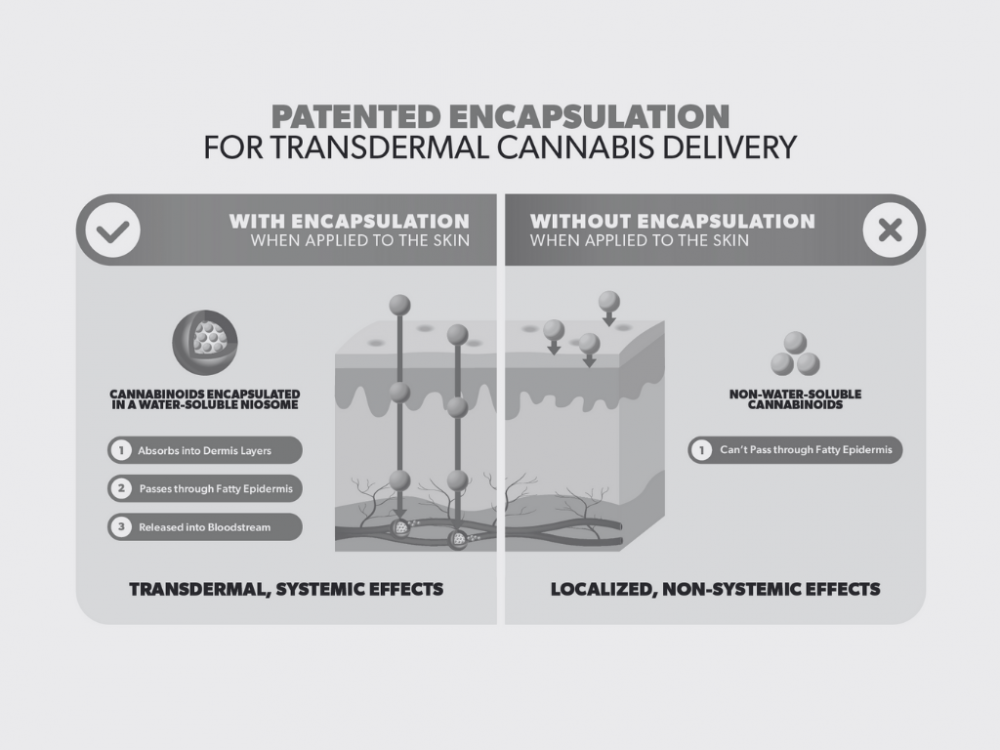
Encapsulation for Transdermal Cannabis Delivery: An Overview
Cannabis harbors a wealth of compounds like cannabinoids, terpenes, and flavonoids, which offer potential medical benefits. One innovative delivery method for these compounds is through encapsulation for transdermal applications. This technique allows for controlled, sustained release, making it a viable alternative to oral ingestion or inhalation.
Understanding Cannabinoids
The crux of cannabis’s therapeutic properties lies in cannabinoids, chiefly THC (tetrahydrocannabinol) and CBD (cannabidiol). While THC is associated with psychoactive effects, CBD is non-psychoactive and holds promise for various therapeutic applications. Both interact with our body’s endocannabinoid system (ECS) to produce their effects (Zou & Kumar, 2018).
The Encapsulation Technique
In transdermal delivery, cannabinoids are encapsulated within lipid-based nanoparticles. These nanoparticles protect the compounds and enable controlled release upon skin application (Stinchcomb et al., 2001).
Advantages of Transdermal Delivery
Transdermal delivery offers a bypass of the gastrointestinal system and liver, reducing potential side effects from oral consumption. Additionally, this method allows for controlled and prolonged release, enhancing the therapeutic efficacy of cannabinoids (Bruni et al., 2018).
The Role of the Skin
The skin comprises multiple layers, including the epidermis, dermis, and subcutaneous layer. The stratum corneum, the outermost layer, acts as a barrier. Hence, the encapsulated nanoparticles must be formulated to pass through this layer effectively (Paudel et al., 2010).
Clinical Applications
Studies have shown efficacy in using transdermal cannabis for conditions like chronic neuropathic pain and arthritis (Lynch & Campbell, 2011; Hammell et al., 2016).
Considerations for Use
The effects of cannabis can vary among individuals, requiring consultation with healthcare professionals for proper usage and dosage.
Enhancing Transdermal Cannabis Delivery: Technologies and Agents
Technologies for Transdermal Delivery
Several technologies exist for transdermal delivery:
- Topical Lotions: Non-occlusive, quickly absorbed but short-lasting effects.
- Creams: Often non-occlusive, longer-lasting than lotions.
- Ointments: Occlusive, provide extended release.
- Patches: Provide controlled release over extended periods.
- Topical + Occlusive Dressing: Increases absorption, maximizes duration of action.
Enhancing Penetration
Alcohol and other solvents can improve skin penetration by altering the stratum corneum’s lipid structure (Williams & Barry, 2012).
Barriers to Penetration
Occlusive dressings and thick petroleum agents may inhibit transdermal absorption by forming a physical or chemical barrier (Williams & Barry, 2012).
Comparison Table of Transdermal Delivery Methods
| Type | Duration of Action | Occlusive/Non-Occlusive |
|---|---|---|
| Topical Lotions | Short-term | Non-occlusive |
| Cream | Medium-term | Often Non-occlusive |
| Ointment | Long-term | Occlusive |
| Patches | Extended | Varies |
| Topical + Occlusive | Extended | Occlusive |
References
- Zou, S., & Kumar, U. (2018). Cannabinoid Receptors and the Endocannabinoid System: Signaling and Function in the Central Nervous System.
- Stinchcomb, A. L., et al. (2001). Human skin permeation of Δ8-tetrahydrocannabinol, cannabidiol and cannabinol.
- Bruni, N., et al. (2018). Cannabinoid Delivery Systems for Pain and Inflammation Treatment.
- Paudel, K. S., et al. (2010). Cannabinoid bioavailability for transdermal drug delivery.
- Lynch, M. E., & Campbell, F. (2011). Cannabinoids for treatment of chronic non-cancer pain; a systematic review of randomized trials.
- Hammell, D. C., et al. (2016). Transdermal cannabidiol reduces inflammation and pain-related behaviours in a rat model of arthritis.
- Williams, A. C., & Barry, B. W. (2012). Penetration enhancers.
Note on Medical Conditions
For certain medical conditions, such as liver or cardiovascular issues, the pharmacokinetics of cannabinoids may differ significantly. For these patients, consultation with Dr. Caplan at CED Clinic for specialized care is highly recommended.
📗 Note: The diagram’s a doodle; the book’s the masterpiece. Be the curator of your own mind museum by clicking here 📗

Summary Notes
Unlocking the Potential of Encapsulation for Transdermal Cannabis Delivery
The field of transdermal cannabis delivery is witnessing transformative advances through the application of encapsulation technologies. Encapsulation offers a sophisticated method to enhance the delivery of cannabis compounds like THC and CBD through the skin, addressing challenges related to solubility, stability, and controlled release.
Encapsulation methods, ranging from nanotechnology to liposomal and microencapsulation techniques, are pivotal in improving the bioavailability of cannabinoids. These technologies enable the creation of delivery systems that can bypass the natural barriers of the skin, ensuring more efficient absorption and utilization of cannabis for therapeutic purposes.
The use of polymer-based materials and nanoencapsulated formulations has shown promising results in enhancing the skin’s permeability to cannabinoids, thereby optimizing the efficacy of transdermal cannabis patches and other products. Stability, a critical factor for the shelf-life and effectiveness of transdermal cannabis, is significantly improved through encapsulation, protecting the cannabinoids from degradation and ensuring consistent dosing.
One of the most compelling aspects of encapsulated cannabis delivery systems is their potential for controlled release. This allows for a steady, prolonged effect, which is particularly beneficial for chronic conditions requiring consistent plasma levels of cannabinoids. The technology also opens the door to targeted therapy, where encapsulated cannabinoids can be designed to act on specific sites, minimizing systemic side effects and maximizing therapeutic benefits.
Safety and regulatory considerations are paramount in the development of encapsulated transdermal cannabis products. Rigorous testing and compliance with regulatory standards are essential to ensure that these innovative products are both effective and safe for consumer use.
Patient experiences and clinical trials are beginning to underscore the potential of encapsulated cannabis in providing relief for a variety of conditions, from chronic pain to inflammatory skin disorders. As research continues to advance, the role of encapsulation in transdermal cannabis delivery is set to expand, promising more precise, effective, and patient-friendly therapeutic options.
Encapsulation technology represents a frontier in cannabis delivery, offering novel solutions to longstanding challenges in the use of cannabis for medical purposes. By enhancing the delivery and efficacy of cannabinoids, encapsulation technologies are poised to play a crucial role in the future of cannabis therapeutics, marking a significant leap forward in the quest for more effective and accessible cannabis-based treatments.

